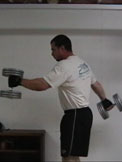|
|
Ab Exercises 2 Dumbbell Swings By Nick Nilson www.fitstep.com/best-ab-exercises/best-ab-exercises.htm The first question that I’m sure pops into your head is “how the heck can you develop your abs without moving the abs at all?” Well, I’m going to tell you exactly how this is done and believe me, the first time you try this exercise, you’ll never look at your ab workout the same way again! You see, oftentimes, the best movements for the abs involve very little bending or flexing of the trunk at all. This is especially true of the exercises that target the deeper core muscles (the transversus and the obliques), which are responsible for stabilizing and transferring power through the core. The exercise you’re going to learn here is going to demand great things from your deep core muscles, so start light and work your way up! This exercise is one of most powerful core-tightening (and waist-tightening) exercises I’ve ever used. It also has the potential to quickly improve performance in just about any sport that requires transfer of power through the core (which is pretty much any sport that I can think of!). So what is this amazing abdominal exercise? THE DOUBLE DUMBBELL SWING! Swing, swing, swing your way to better abs! Sure, it sounds like a late night infomercial but in this case, it’s actually going to get you an extremely intense ab workout! I’m going to tell you how to use momentum to cinch up your core like the steel corset I mentioned. Imagine a cross-country skier. Now focus on the alternating action of the arms. When the left one goes forward, the right one goes back. Then the right goes forward and the left goes back, all in a very rhythmic movement. Plant that image of the skier in your head. Now put a couple of dumbbells in that skiers hands instead of poles! In a nutshell, with this exercise you’re going to be doing cross-country skiing with your arms while holding dumbbells in your hands. Sounds easy, right? On paper, sure. In reality, you’re going to be in for a shock! So why is this weighted "skiing" movement good for the abs? Well, first think about where the tension (from the dueling momentum of the dumbbells moving in opposite directions) is going through: the core. As one dumbbell is swinging down, the other is swinging up and it falls to the deep muscles of the core to not only stabilize the spine and body but to also provide muscular force to help keep those dumbbells swinging. This opposing torque on the abs results in a TREMENDOUS tightening of the deep muscles of the core, especially when both dumbbells are at the bottom of their swings and heading back up. All the momentum in those dumbbells is now going to go directly through your core. The bonus: when you do the exercise, it will affect your ENTIRE body (I can promise you that!), giving you the benefits of interval training in addition to the direct effects on the abs. How To Do It: First, pick up two dumbbells, one in each hand, and stand up straight. Start fairly light (use approximately what you can do for 10 to 12 reps on the dumbbell curl) – you will be working your way up to heavier weights as you get stronger and more experienced with the exercise. Keep your feet close together (a few inches apart at the most). If your feet are set too wide, the dumbbells will contact your thighs at the bottom of the movement. Keeping the feet closer together also forces the abs to do more of the stabilizing as your body can’t rely on the legs to absorb as much of the momentum of the swinging dumbbells. This exercise, in order to get a good swing going (especially with heavier dumbbells), will require a carefully timed dip in the knees. So on your very first rep, start by dipping slightly in the knees then popping back up. As you pop back up, use this momentum to start your right dumbbell swinging forward and up and your left dumbbell swinging back and up. As the dumbbells start to come back down, dip your knees down again. As your left hand swings forward and your right hand swings back, pop back up strongly again. You are using your legs to add momentum to the dumbbell swings, getting them up higher and giving you the ability to use heavier dumbbells. Repeat this dip and pop up EVERY time the dumbbells come down to the bottom and start to come back up.
As you do this exercise, try not to let your torso twist back and forth much. Do your best to keep your shoulders and hips square and unmoving so that all the torque goes through the core and you don’t get any sharp twisting movements in the spine. Your shoulders WILL move somewhat (there is no getting around it) but by trying to keep still, you will minimize the movement. Keep your arms rigid and locked into position as you swing the dumbbells up and down. For height, you want to aim for about shoulder height in front of you (similar to a front delt raise) and a little lower behind you (the mass the triceps will stop the range of motion behind you). Keep control of the weight and your torso throughout the movement – no wild swinging. Exhale forcefully each time you pop up (imagine as though you’re trying to blow the dumbbell forward). .


If the dumbbells are too light and you find the exercise is not challenging your abs after a few reps, increase the weight. Keep going for as long as you can with good form. When you can’t swing the dumbbells very high or you feel your core strength starting to give out (i.e. your shoulders and hips start twisting too much for your core to control), stop the swinging and set the dumbbells down. At this point, you’re going to be huffing and puffing like crazy – this exercise works not only your entire upper body, but also involves your lower body strongly each time you use your legs to pop up. Cross-Country Skiing is one of the most demanding total-body cardio exercises you can do...now you’re doing it with weights! So how heavy should you go with this exercise? That will depend on how strong your core is (work up to it – don’t start heavy!) and how heavy your dumbbells go! You can build up to some very good weights with this exercise – I’ve personally gone up to a pair of 85 lb dumbbells. The more weight you can safely use with this exercise, the stronger and more powerful your entire core area is going to get. Single-Arm Variation Looking for another unique challenge? Try the Dumbbell Swing exercise holding only one dumbbell to one side. Hold your other arm wide to the other side (to help counterbalance) and use it to add momentum to swinging the dumbbell up. Do not dip your knees with this variation – you should use trunk rotation and help from swinging your free arm to get the dumbbell moving. 
Here’s a trick you can try with it: when you swing the dumbbell to the top of the arc, try and hold it there for a second. That brief effort to stop the dumbbell at the top will hit the obliques HARD simply because, more than likely, you won’t be able to overcome the inertia of the dumbbell and actually hold it up. But at that moment when you try and stop it, the obliques are going to be hit with a VERY strong eccentric contraction in their effort to try and stop the dumbbell. With the one-arm variation, shoulder and hip rotation is desirable. Since you don’t have the opposing force on the other side (or the dipping of the legs), use rotation in your waist to help accelerate the dumbbell forward and up. Conclusion: -Nick Nilsson For a video of these two exercises variations in action, click on either of the following links (Windows Media or Quicktime)
Click Here To Visit Nick Nilsson's Website And |
|
|||||||









